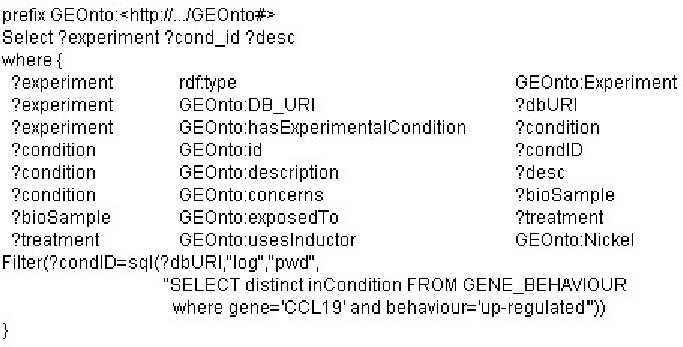Database Reference
In-Depth Information
Figure 14. Example of a rule describing biologist knowledge
in the semantic search engine CORESE, a new
function
sql
with four arguments: the database
URL, the username, the password and the query.
The purpose of this function is to evaluate the
SQL query on the given database.
Figure 15 shows the CORESE query that
matches the following question:
“In which oth-
ers experiments using a Nickel treatment, CCL19
gene is up-regulated”
In this example:
on the referred database
?dbURI
and returns
the list of condition URIs where CCL19
gene is up-regulated (
gene='CCL19'
and
behaviour='up-regulated'
)
The SPARQL query filters conditions con-
•
tained into the previous list returned by the
SQL clause (
Filter (?condID=sql(...)
).
The result is a list of triples. Each triple con-
tains:
•
The SPARQL query retrieves all condi-
•
the experiment URI (e.g.
GSE6281
),
the condition identifier (e.g.
tions (
?condition
}) using a Nickel treat-
ment (
?treatment GEOnto:usesInductor
GEOnto:Nickel
) and the URI of the da-
tabase (
?dbURI
) where the information
about genes behaviour is stored .
The sql function evaluates the SQL query
•
GSM144309
),
the description of the condition (e.g.
•
Female (age range 33-49), skin biopsy
from upper dates taken 7 hours after nickel
exposure
).
•
(
'SELECT distinct inCondition FROM...'
)
Figure 15. Example of a CORESE query using SQL embedded in SPARQL


Search WWH ::

Custom Search